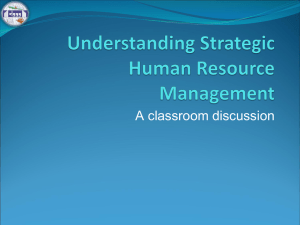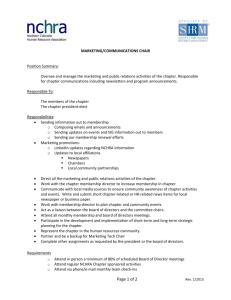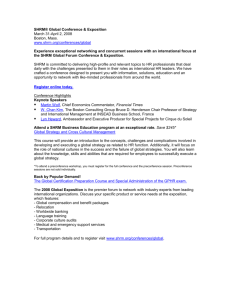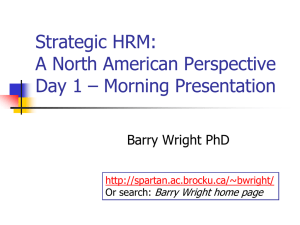Strategic Human Resource Management and Theoretical
advertisement
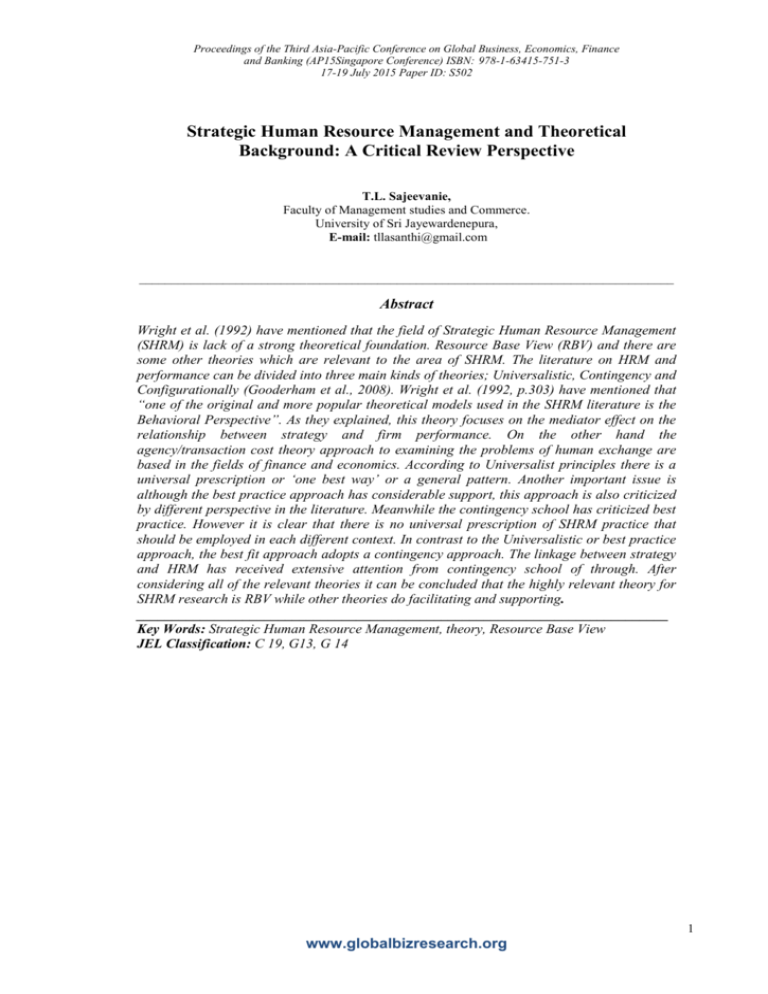
Proceedings of the Third Asia-Pacific Conference on Global Business, Economics, Finance and Banking (AP15Singapore Conference) ISBN: 978-1-63415-751-3 17-19 July 2015 Paper ID: S502 Strategic Human Resource Management and Theoretical Background: A Critical Review Perspective T.L. Sajeevanie, Faculty of Management studies and Commerce. University of Sri Jayewardenepura, E-mail: tllasanthi@gmail.com ___________________________________________________________________________________ Abstract Wright et al. (1992) have mentioned that the field of Strategic Human Resource Management (SHRM) is lack of a strong theoretical foundation. Resource Base View (RBV) and there are some other theories which are relevant to the area of SHRM. The literature on HRM and performance can be divided into three main kinds of theories; Universalistic, Contingency and Configurationally (Gooderham et al., 2008). Wright et al. (1992, p.303) have mentioned that “one of the original and more popular theoretical models used in the SHRM literature is the Behavioral Perspective”. As they explained, this theory focuses on the mediator effect on the relationship between strategy and firm performance. On the other hand the agency/transaction cost theory approach to examining the problems of human exchange are based in the fields of finance and economics. According to Universalist principles there is a universal prescription or ‘one best way’ or a general pattern. Another important issue is although the best practice approach has considerable support, this approach is also criticized by different perspective in the literature. Meanwhile the contingency school has criticized best practice. However it is clear that there is no universal prescription of SHRM practice that should be employed in each different context. In contrast to the Universalistic or best practice approach, the best fit approach adopts a contingency approach. The linkage between strategy and HRM has received extensive attention from contingency school of through. After considering all of the relevant theories it can be concluded that the highly relevant theory for SHRM research is RBV while other theories do facilitating and supporting. ___________________________________________________________________________ Key Words: Strategic Human Resource Management, theory, Resource Base View JEL Classification: C 19, G13, G 14 1 www.globalbizresearch.org Proceedings of the Third Asia-Pacific Conference on Global Business, Economics, Finance and Banking (AP15Singapore Conference) ISBN: 978-1-63415-751-3 17-19 July 2015 Paper ID: S502 1. Introduction Today, Human Resource Management (HRM) has become more important to strategic management, mainly as a result of its role in providing competitive advantage and the rush to competitiveness. According to Wright, Dunford and Snell (2001) HR practice could not form the basis for sustainable competitive advantage but human capital pool has greater potential to constitute a source of sustainable competitive advantage. Wright et al. (2001) have explained human capital pool means skillful employees in the organization. With this rapid development of the globalized economy, both practitioners and academics have identified the importance of Human factor for the success of an organization. Human Resources are seen as “the available talents and energies of people to an organization as potential contributors to the creation and realization of the organization’s mission, vision, strategy and goals (Jackson & Schular, 2000, p.37). SHRM is becoming ever more popular. According to Jain (2005) SHRM is not a completely new and revolutionary field rather its roots can be traced back to the mid – 1950s. More specially, the birth of Strategic Human Resource Management (SHRM) came in the early 1980’s with Devanna, Fombrum and Tichy’s (1984) article devoted to extensively exploring the link between business strategy and HR (Wright et al., 2001). Theory on the relationship between HRM and economic success has grown significantly over the past 15 years (Chang at el., 2005). This theoretical progress can be seen in two different arenas: meta – theories describing broad rationales for why HRM and economic success should be linked, and middle – level process theories describing how this linkage takes place (Wright, 2005). In the first arena, the state of theory in SHRM research, was at best “borrowing” meta – theories from other disciplines, and at worst almost completely a theoretical. The theories that used at that time were resource – based theory, the behavioral approach, open systems theory, and control theory with a few authors exploring population ecology and critical theory (Wright, 1992). After several years Wright, 1992, had mentioned that the resource- based theory of the firm had become almost the universally embraced meta-theory among SHRM researchers, largely because of both its popularity in the broader strategic literature, and its ability to articulate why HRM could be linked to the economic success of firms (Wright, 2005). A good theory enables one to both predict what will happen given a set of values for certain variables and to understand why this predicted value should result (Wright & Mcmahan, 1992). An accurate theoretical model allows for better decision making in conditions of uncertainty. Due to the applied nature of SHRM it is exceedingly important that the field develop use theoretical models that allow for both predicting and understanding the effects of HR practices on organizational functioning (Wright et al., 1992). Much of the writing in the field of SHRM has been concerned with either practical advice or presentation of empirical data. Without having a good theory, the field of SHRM could be characterized as 2 www.globalbizresearch.org Proceedings of the Third Asia-Pacific Conference on Global Business, Economics, Finance and Banking (AP15Singapore Conference) ISBN: 978-1-63415-751-3 17-19 July 2015 Paper ID: S502 a Plethora of statements regarding empirical relationships and/or prescription for practice that fail to explain why these relationships exist or should exist. Theories assumes a somewhat rational, proactive decision making process as the major influence on the development and alignment of various HRM practices. Also these theories seem to be the most useful for examining SHRM because they attempt to predict (Wright et el., 1992). Some writers have argued that lack of any theoretical foundation for describing the SHRM function in organization (Delery & Doty, 1996). But Wright et al. (1992) have mentioned that this is valid a few years ago. Further they have mentioned that recent SHRM scholars have relied on various theories from the organizations literature as a basis for developing a more fully articulated theory of Human Resource Management. 2. Kind of Theories (Universalistic, Contingency and Configurationally Theories Agency/Transaction Cost Theory) The literature on HRM and performance can be divided into three main kinds of theories universalistic, contingency and configurationally (Gooderham et al., 2008). Wright et al. (1992, p. 303) have mentioned that “One of the original and more popular theoretical models used in the SHRM literature is the Behavioral Perspective”. As they explained, this theory focuses on the mediator effect on the relationship between strategy and firm performance. As Wright et al. (1992, p. 305) empathies “Another set of popular theoretical models being applied to SHRM research is the use of cybernetic systems models”. An agency/transaction cost theory approach to examining the problems of human exchange are based in the fields of finance and economics (Wright et al., 1992, p. 308). “The implications of the institutional perspective for SHRM are important” (Wright et al., 1992, p. 314). The best practice approach to managing people is based on Universalist principles that assume some HRM practices are appropriate for all organizations (Armstrong, 2009). According to this there is a universal prescription or ‘one best way’ or a general pattern that can be adopted by various organizations to manage their people, without considering organizations circumstances. Another important issue is although the best practice approach has considerable support, this approach is also criticized by different perspective in the literature. Further, the resource based view Purcell (1999) argues that organizations should use their resources, including intangible assets such as human resources to promote their overall model and to be better than their competitions. Another important part to be mentioned here is the contingency school has criticized Best practice. However it is clear that there is no universal prescription of HRM practices that should be employed in each different context. In contrast to the Universalistic or best practice approach, the best fit approach adopts a contingency approach. The linkage between strategy and HRM has received extensive attention from contingency school of thought. By considering all these it can be concluded that by empathizing Wright et al. (1992, 3 www.globalbizresearch.org Proceedings of the Third Asia-Pacific Conference on Global Business, Economics, Finance and Banking (AP15Singapore Conference) ISBN: 978-1-63415-751-3 17-19 July 2015 Paper ID: S502 p. 316) explanation on important of theory for a researcher, “unless SHRM research becomes strongly grounded in theories of organizations, others may view the prescriptions of SHRM as being similar to burning down a house in order to cook the pig (Please see the Annex 1 for the story). After considering all the relevant theories the highly relevant and recommended theory for this research is RBV while other theories facilitating and supporting. 2.1 Strategic Human Resource Management and Resource based View (RBV) One of the major areas of theoretical development in SHRM is associated with the resource- based view (RBV) of the firm. Barney, (2001) mentioned that in the strategic management literature, resource –based view (RBV) is currently receiving a significant amount of attention. Meanwhile Wright et al. (1992) empathized that there is a great potentiality exists for the use of RBV in SHRM research. “Resource – based view has proven to be integral to the conceptual and theoretical development of the SHRM literature” (Wright et al., 2001, p. 706). Wright et al., have explained further the evolution of the Resource – based view (RBV) based SHRM began when HR researchers recognized that RBV provides explanation of the relationship between HR practice and competitive advantage. RBV essentially explains and predicts the relationship between the particular resources of a firm and sustainable competitive advantage by performance – related outcomes (Armstrong & Shimizu, 2007). Lockett, O’shea and Wright, (2008) explained that the publication of Berger Wernerfelt’s who is one of the founding fathers of the field of strategic management, article on “Resource based view of the firm” in 1984 the strategic management field has embraced the notion that firm fundamentally heterogeneous in terms of their resource and internal capabilities. The resource –based view of the firm is a mixture of theories and this is a strategic management theory that seeks to identify the resources that may provide firm with a sustainable competitive advantage (Maijoor & Witteloostuijn, 1996). According to them some of the resources are: brand names, employment of skilled personnel, machinery etc. Barney et al. (2001) have mentioned that these resources as bundles of tangible and intangible assets, including a firm’s management skills, its organizational processes and routines, and the information and knowledge. Resources are important to the organizations since they are valuable, rare, costly to imitate, and non –substitutable (Armstrong et al., 2007). Also they further explained that valuable, rare, costly to imitate, and non –substitutable resources can be a source of sustained competitive advantage to the extent that there are no strategically equivalent resources (Armstrong et al., 2007). There are empirical SHRM studies that have used the RBV as the basis for exploring the relationship between HR and firm performance and it has significantly and independently influenced the field of strategy and SHRM (Wright et al., 2001). Since within the area of SHRM, the RBV has made important contribution (Wright, Dunford, and Snell, 2001, p. 701) 4 www.globalbizresearch.org Proceedings of the Third Asia-Pacific Conference on Global Business, Economics, Finance and Banking (AP15Singapore Conference) ISBN: 978-1-63415-751-3 17-19 July 2015 Paper ID: S502 “the resource –based view (RBV) of the firm has influenced the field of SHRM in a number of ways”. Although many challenges in empirically testing the RBV constructs still remain (Armstrong et al., 2007) “The popularity of the RBV within the SHRM literature as a foundation for both theoretical and empirical examination has probably for surpassed what anyone expected (Wright et al., 2001, p. 702). As Wright et al. (2001) explained RBV differs from the traditional strategy paradigm and it emphasis links between strategy and internal resources of the firm. Further they discussed the traditional strategy model, considered resources are exchangeable so firms could purchase or create resources held by a competing firm. Theory is necessary at each and every step of the research (Uyangoda, 2010). There are several groups of theories dealing with the content of the integration between business strategy and human resource management. Some of them are behavioral theories; resource-based theories; interactive theories, based on the open systems theory (Dhar, 2010). Accordingly behavioral theories are based on the assumption that for the realization of a certain business strategy certain employee behavior is necessary. Also it can be identified employee behavior forms the bridge between business strategy and firms performance. Similarly there are number of studies that can be identified within this behavioral approach. Further as Dhar (2010) mentioned “to the extent that the above – mentioned studies are based on empirical observations, their results are somewhat ambiguous”. Wright et al. (1992) has mentioned the according to Dubin (1976) theory is “the attempt……. to model some aspect of the empirical world”. Further Wright et al. (1992) has explained that a well-developed theoretical model allows for testing of the model and based on these tests, revision of the model to increase its accuracy. To date two primary perspectives – a universal approach and a contingency approach have been used to describe the link between human resource management (HRM) and firm performance (Wright et al., 1992). They further have mentioned that the universal or best practice perspective implies a direct relationship between particular approaches to human resources and performance, and the contingency perspective posits that an organization’s strategic posture either augments or diminishes the impact of HR Practices on performance. They have mentioned that going beyond these direct HR performance relationships, however other evidence suggests that the impact of HR practice on firm performance may be further enhanced when practices are matched with the competitive requirements inherent in a firm’s strategic posture. 3. Discussion and Recommendation As mentioned above Wright et al. (1992, p. 315) have explained a good theory enabling one to predict what will happen given a set of values for certain variables and “the role of 5 www.globalbizresearch.org Proceedings of the Third Asia-Pacific Conference on Global Business, Economics, Finance and Banking (AP15Singapore Conference) ISBN: 978-1-63415-751-3 17-19 July 2015 Paper ID: S502 theory in SHRM must continue to increase if the field of SHRM is to move forward. According to Amstrong (2001) SHRM in reality is not usually a formal, well –articulated and linear process which floes logically from the business strategy. However there is a growing literature on the impact of HRM practice on organizational performance (Gooderham et al., 2008). They further discussed the impact of HRM practice on organizational performance is commonly underpinned by the resource-based view of the firm with its emphasis on gaining sustainable competitive advantage by means of effective and efficient utilization of the resources of the organization. A strong theoretical model has great value to theoristresearchers, to test the model and based on these tests; revise the model to increase the accuracy (Wright et al., 1992). Also they have pointed out that for the field of SHRM it is very important to use theoretical models that allow for both predicting and understanding the effect of HR practices on organizational functioning. Baird et al. (1988) had mentioned that there is no overall model that explains how human resource can be managed to achieve the business needs. Further, Wright et al. (1992) have mentioned that the field of SHRM is lack of a strong theoretical foundation. But they further argue that, this may have been valid a few years ago. “Recent SHRM scholars have relied on various theories from the organizations literature as a basis for developing a more fully articulated theory of human resource management” (Wright et al., 1992, p. 300). They have proposed a conceptual model of theoretical framework for studying SHRM (Figure 1). In this model there are several variables called, human resource practice, the human capital resource pool, the specification of required human resource behaviors and the effectiveness of business strategies, Institutional forces, and firm level outcomes (Wright et al., 1992). References Armstrong, C. E., & Shimizu, K., 2007, A Review of Approaches to Empirical Research on the Resource-Based View of the Firm. Journal of Management, 33(6), 959-986. Baird, L., & Meshoulam, I., 1988, Two fits of Strategic Human Resource Management. The Academy of Management Review, 13(1), 116-128. Barney, J. B., 2001, Is the resource-based “view” a useful perspective for strategic management research? Yes. Academy of Management Review, 26(1), 41-56. Chang, W.A. & Huang, T. C., 2005. Relationship between Strategic Human Resource Management and firm performance. International Journal of Manpower. 26, (5), 434-449. Dess, G.G. & Davis, P.S., 1984., Porter’s generic strategies as determinants of strategic group membership and organizational performance, Academy of management Journal, 27, 467- 488. Dhar, R.L., 2010. Strategic Human Resource Management, New Delhi, Excel Printers. Golden, K., & Ramanujam, V., 1985. Between a Dream and Nightmare: On the integration of the human resource management and strategic business planning processes. Human Resource Management, 24, 429-425. 6 www.globalbizresearch.org Proceedings of the Third Asia-Pacific Conference on Global Business, Economics, Finance and Banking (AP15Singapore Conference) ISBN: 978-1-63415-751-3 17-19 July 2015 Paper ID: S502 Jain, P., 2005. A comparative analysis of strategic human resource management (SHRM) issues in an organizational context. Library Review, 54, (3), 166-179. Maijoor, S., & Witteloostuijn, A.V., 1996, An Empirical test of the Resource-Based Theory: Strtegic Regulation in the Dutch Audit Industry. Strategic Management Journal. 17, 549-569. Opatha, H.H.N.P., 1997, Strategic HRM as part of Strategic Management: A theoretical Perspective. Vidyodaya Journal of Social Science, 8, (1), 103-119. Purcell, J., 1999, Best Practice and best fir: chimera or cul-de-sac? Human Resource Management Journal, 9(3): 26-41. Sajeevanie, T.L., & Opatha, H.H.D.N.P., 2007, Relationship between Human Resource Manager related factors and practice of Strategic Human Resource Management in Sri Lankan Listed Firms. Sri Lankan Journal of Human Resource Management, 1, 71-87. Uyangoda, J., 2010, Writing Research Proposals, in the social sciences and humanities, Colombo, Social Scientists’ Association. Wright, P.M., & Mcmahan G.C., 1992, Theoretical Perspective for Strategic Human Resource Management. Journal of Management, 18(2), 295-320. Wright, P.M., Dunford, B.B., & Snell, S.A., 2001, Human resource and the resource based view of the firm. Journal of Management, 27, 701-721. Annex 1 Importance of theory for a research How the human race discovered cooking Wright et al., (1992, 316) have quoted from Kanter (1983) as “She related a parable explaining how the human race discovered cooking. According to the parable, during a primitive time in china, people ate their food raw. One day man left his son in charge of the house, and son accidently set the house on fire, burning the family pig. Upon returning home, the man was poking around in the debris and inadvertently stuck his finger in the burned pig. This burned his finger, and he quickly withdrew it, sticking his finger in his mouth to relieve the pain. He found that the taste was delicious, hence, discovering cooking. Based on that new experience, whenever anyone wanted roast pig, they would burn down their house. As Kanter explains, the moral of the story is: “if you don’t understand why the pig gets cooked, you are doomed to waste an awful lot of houses”. 7 www.globalbizresearch.org
